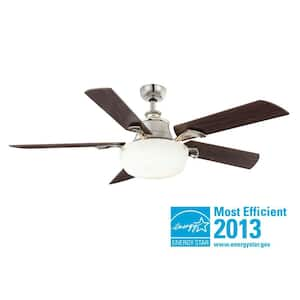As I progress through renovating the new house I am replacing several fixtures and appliances, starting with a ceiling fan which lacks a much needed light fixture. So doing all this work with energy efficiency in mind I start browsing Energy Star rated fans at major retailers. As I look through these fans and see all the yes/no binary ratings I am wondering how they are actually compared, and whether efficiency can really be a yes or no question. So upon some further reading on the EnergyStar.gov site, I find that they supply a handy excel sheet with all the products they rate, but much more importantly, they give actual data on each product. Armed with this I start looking at the differences in ceiling fans and it's HUGE! They are compared by using the cfm/watt measurement, this is the cubic feet per minute of air they move for each watt of electricity consumed, the range spans a large gamut of values. I want something in the 50-54 inch diameter range, in this size, at medium speed, fans range from 100 CFM/Watt to 616 CFM/Watt !
So back to Home Depot armed with the list of fans, I see that most of the fans with a CFL light fixture and an energy star label are hovering around that 80-100 cfm/watt level and are around $100.
I end up with a Hampton Bay Winfield that moves 327 CFM of air per watt on medium, and looks pretty sharp too. It cost me $209 at Home Depot, so how did I do versus the cheaper non energy star rated fans?
Lets look at usage first, here in New England we run our fans during the winter and the summer, to move the warm and cool air to where you want it. Lets suppose that on average during the summer the fans runs for 8 hours a day for 30 days, and for 12 hours a day for 30 days. then during the winter lets suppose it runs for 6 hours a day for 60 days, for a total use of 960 hours per year. Wow, more than I expected, maybe that's on the high side but lets run with it. So over those 960 hours, the Hampton Bay Winfield uses 8 watts (3493 cfm) x 960 hours = 7680, divide by 1000 and you get 7.680 kWh, the method by which most utilities charge you. I currently pay .14074 per kWh, so the Winfield costs me $1.08 per year to run for 960 hours....wow not bad at all.
Compare to the Hampton Bay Brookhurst which uses 58 watts on medium to move 4468 cfm of air (~77 cfm/watt). Over a year at 960 hours of use this costs $7.83, an increase of $6.75 per year...over the life of the 30 year warranty period that's a savings of $202.5, its not huge but if you approach every fixture and appliance in your home this way, the savings will add up. Keep in mind this is at today's electricity rate, if this rate climbs over the next few years, the savings just multiply.
Here is the Winfield at Home Depot, check it out.

No comments:
Post a Comment